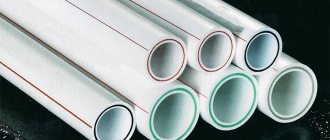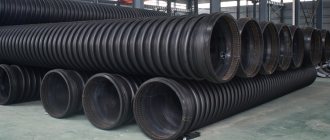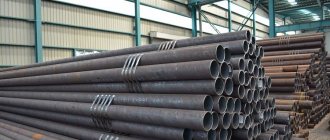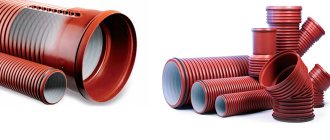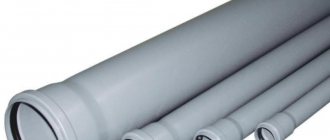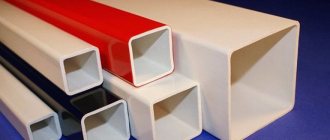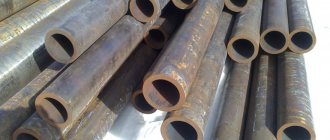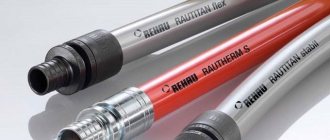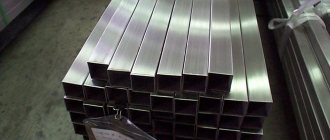Every year, polypropylene pipes are becoming more and more in demand when arranging communications, which is due to the high quality of such products, their versatility and wear resistance. When using polypropylene pipes, it is possible to equip not only reliable and safe internal systems, but also external water supply systems. This is the most affordable option for creating heating and plumbing communications. However, the most popular are PN20 polypropylene pipes, which have a number of features and advantages.
Polypropylene pipes
About PPRC pipes - explanation
The invention of high-temperature polypropylene was a fairly major event in the modernization of plastics technology. It is interesting that the material began to be used in industry immediately after the completion of work on creating a universal plastic mass.
The widest area of application of a substance with this PPRC decoding is the production of pipes used to transport not only aqueous solutions, but also chemically active media.
It should be noted that the abbreviation PPRC is rarely found on pipes. More often you can see the inscription PPR. Therefore, some potential buyers are sure that PPR and PPRC are completely different materials. Although, in reality, this is not entirely true.
The fact is that the combination of letters PP means that the material used for manufacturing is polypropylene. But the name “block copolymer of polypropylene with the presence of polyethylene” in English is written as follows: PPRC - PolyPropylene Random Copolymer.
Since at this time there are no uniform rules for markings on polypropylene pipes, it is not always possible to understand exactly what is written on them. After all, each manufacturer has its own marking technique.
PPR pipes are the most popular and in demand. What does PPRC marking have to do with it, you ask?
Important! Remember that PPR products are a variant of the broader class of PPRC tubes.
PN20 pipes: main characteristics
PPRC PN20 pipe is used for laying cold and hot water supply networks, in which the maximum operating pressure does not exceed 2 MPa. Moreover, it is precisely these products shown in the photo that are used in the process of installing heated floors, as well as in the creation of industrial pipelines that supply process solutions and compressed air to production facilities.
The unique physical and mechanical characteristics of the PN20 pipe determine such a wide range of uses for such a product.
The most basic advantages of polypropylene pipes, which are described in more detail in GOST, include the following:
- with high strength values, such products have very good elasticity;
- low adhesion rates;
- resistance to corrosion;
- chemical inertness;
- excellent resistance to various shock loads;
- low thermal conductivity;
- excellent vibration and sound absorption capabilities.
It is thanks to these features that the PPR PN20 pipe acquires unique technical and consumer characteristics. To install a pipeline using such products, you will not need to use expensive specialized equipment, since the polymer can soften already at a temperature of +132°C, which means it is possible to obtain hermetically sealed connections without high-temperature welding.
Corrosion resistance and chemical inertness will be the best guarantee that foreign impurities will not penetrate into the water. And the adhesive properties of the surface eliminate the possibility of overgrowing the inside of the pipe with salts and limestone formations.
Also, a significant advantage that the polypropylene pipe PN20 205 has is its low thermal conductivity, which allows for significant savings in the arrangement of warm water supply.
PPRC Polypropylene
Over time, one design is replaced by another. Metal pipes, which have served humanity for a long time, were no exception. They were used (and are partially still used) in the construction of hot and cold water supply systems, for heating and sewer lines.
But recently they have begun to be replaced with polypropylene (PPRC or PPR) pipes of different diameters.
Why was such a replacement possible?
There are several reasons for this.
Firstly , practicality, anti-corrosion properties of plastic products. It is known that plastic, especially high-temperature plastic, is not subject to corrosion, that is, it does not rot or rust. Steel analogues cannot serve as much due to corrosion processes.
It is clear that with galvanic coating
metals last a long time. But such a procedure is too expensive, and the total cost of the pipeline is very high.
So why spend extra money if there is a good substitute?
– PPRC pipes, the technical characteristics of which are not inferior to their metal counterparts.
Secondly. For the manufacture of these products, polymerized polypropylene is used, the price of which is significantly lower than steel. So the monetary savings are obvious, which is very important for many consumers.
Third. Many people know that water in metal water pipes often freezes in winter, which can lead to expansion and sometimes cracking of the risers. This is due to the lack of elasticity of metals. The greater elasticity of polypropylene allows pipes to partially increase their diameter when water freezes in them. That's all. At positive temperatures, the ice will begin to melt, and the riser will take its previous shape.
Comparison with metal products
Polypropylene PPRC products have found their application in the arrangement of heating systems not only in private homes, but also in shops, pharmacies, clinics, etc.
The practicality of this application is obvious, since the coolant is water, the boiling point of which is about 100⁰C. Thermoplastic products can withstand temperatures up to +95⁰С. And more is not necessary, since no one brings the water in the heating system to a boil.
If such heating is done in a country house, where you rarely visit, then the option of depressurization (“defrosting”) the heating system made of metal parts is possible. This cannot be said about the construction of polypropylene pipes, which have plastic properties.
According to the comparative characteristics of installation, it can be noted that steel parts must be connected by welding or threading. To do this, you need a welding machine, electrodes, tow or fum tape, sealant and other materials.
Polypropylene parts are joined with a special welding machine, the cost of which is lower than its metal counterpart. In addition, the docking process lasts 10-12 seconds, which significantly reduces connection time. The joints are sealed, strong and reliable.
How PPR products are connected
The essence of the operation of the welding machine is as follows: the inner and outer surfaces of the pipe are simultaneously heated. The readiness for welding is indicated by the softening of the thermoplastic.
After this, in the same heated form, the parts are smoothly connected to each other by hand.
After ten seconds, the plastic will cool down and the joint, like the whole structure, is ready for use.
But, nevertheless, in practice they act differently:
First, this section of the pipeline is allowed to cool completely for 3-4 minutes, after which the structure is operated. This is due to possible high loads of a mechanical type: impacts, falls, the actions of which can lead to cracking of the joint.
According to their structure, the parts are thin-walled (used in systems with pressures up to 10 atm.) and thick-walled (up to 20 atm. - PPRC pn20 pipe).
For example, in heating structures the use of thick-walled reinforced polypropylene pipes is observed. The fact is that aluminum-reinforced products on the outside make the pipeline more durable in the presence of high temperatures (up to +95⁰С). The coolant can sometimes have this temperature, although rarely. It should be noted that the pipe can withstand temperatures above 100⁰С, but in a short-term mode. True, it’s not worth the risk. Although the products are produced with a sufficient margin of safety, which eliminates the possibility of rupture.
When installing pipes reinforced with aluminum foil, some time is spent cleaning the end of the foil product. But a reliable connection completely eliminates the loss of time.
Polypropylene pipes. Specifications.
Currently, polypropylene pipes are used in all possible ways: water supply, heating, drainage, ventilation. In terms of price/quality ratio, this is the most suitable option for installing such pipes, not only in industry, but also in households. The most important advantage of such pipes is their resistance to corrosion and, accordingly, durability. On average, the service life of such pipes reaches 50 years. Thanks to them, the use of steel and cast iron pipes fades into the background.
Installation of polypropylene pipes is convenient and quick, which allows you to quickly install water supply systems, heating systems, etc. An important advantage of these pipes is their resistance to internal deposits and deposits. Pressure losses in polypropylene pipe systems are minimal. Resistance to negative temperatures is high, which means that the likelihood that the pipe will crack when frozen is minimal.
It is not difficult to guess that the material used in the manufacture of these pipes is polypropylene. Polypropylene is a synthetic polymer, a class of polyolefins obtained by the polymerization of propylene. The main advantage of propylene is its low cost, and it is not harmful to the human body. Polypropylene has high strength with relatively low weight.
There are 4 types of polypropylene pipes: 1. The first type with a working pressure of 1 MPa (PN10); 2. The second with a working pressure of 1.6 MPa (PN16); 3. The third with a working pressure of 2 MPa (PN20); 4. The fourth type with a working pressure of 2.5 MPa (PN25).
The weight of a linear meter of polypropylene pipes may vary depending on the nominal pressure and pipe design. Currently, there are many factories that produce polypropylene pipes; as a result, pipes can have different designs and weights, so when purchasing a pipe you need to contact the company and find out all the necessary technical characteristics of polypropylene pipes. Below are the average weight of polypropylene pipes with pressure PN 10, PN 20, PN 25, as well as a table of the calculated pressure of polypropylene pipes PN 10, PN 16 PN 20, PN 25 depending on service life and temperature.
.
D - outer diameter of polypropylene pipe, mm;
S is the wall thickness of the polypropylene pipe, mm.
Fig. 1. Dimensions of polypropylene pipe.
Theoretical weight and dimensions of polypropylene pipes PN10.
Table 1
Theoretical weight and dimensions of polypropylene pipes PN10.
| D, mm | S, mm | Weight, g/m |
| 20 | 1,9 | 110 |
| 25 | 2,3 | 159 |
| 32 | 2,9 | 253 |
| 40 | 3,7 | 398 |
| 50 | 4,6 | 625 |
| 63 | 5,8 | 981 |
| 75 | 6,8 | 1380 |
| 90 | 8,2 | 1980 |
| 110 | 10,0 | 2950 |
Polypropylene pipes PN10 are intended for cold water supply systems, the temperature range of such pipes is up to +20 C˚. The working pressure of such pipes is 1 MPa. Internal diameters vary from 16 to 90 mm, external diameters from 20 to 110 mm, with wall thicknesses from 1.9 to 10 mm.
PPRC aluminum reinforced
Among all polypropylene risers, the most reliable is PPRC pipe reinforced with aluminum. The product can function even at temperatures of +115⁰С – +120⁰С
, without expanding at all.
If necessary, the pipeline can be efficiently operated at higher temperatures. But there is no need to abuse this, even if the manufacturer provides a certain margin of safety for these products.
A solid or perforated aluminum layer is joined with glue, which provides the structure with less strength, but reduces expansion during heating.
What is the secret of aluminum reinforcement?
It's all about the structure of the product: the presence of foil prevents thermal expansion. Therefore, structures made from aluminum-reinforced parts are often used for the installation of high-temperature water or steam heating systems. Although they are successfully used in the construction of hot and cold water supply lines.
The design provides for several ways to place metal in polypropylene pipeline elements. To do this, the foil is joined end-to-end or overlapping, closer to the inner surface, to the middle or on the outer side. Products are also produced with perforated foil.
The properties of pipe products are determined by the foil layer
1. With external reinforcement, installation of products becomes more difficult. At the same time, it will take more time to set up the system, since it takes 20-25 seconds to clean the top layer of products.
Important!
Stripping products from foil (facing pipes) is a very important and necessary step before welding products, since failure to perform this procedure may cause pipe destruction. 2. When reinforced with solid foil, the possibility of oxygen penetrating inside the system is completely eliminated.
This prevents the onset of corrosion processes in metal network elements. In this case, high-quality gluing of the polypropylene layer with a reinforced coating is required. Otherwise, moisture may seep through the polymer, and drops of water may appear on the foil, which will lead to the destruction of the riser. Important!
Choose the highest quality pipe products that are manufactured by reputable companies. 3. When using perforated type of foil, the connection becomes better.
But in this case, it is possible for air to penetrate inside the system. The best option is to place perforated foil between the inner and outer walls of polypropylene. In this case, the possibility of deformation of the elements in the event of heating, as well as the penetration of air into the coolant, is eliminated.
PPRC glass fiber reinforced
Unlike polypropylene risers reinforced with aluminum foil, reinforcement of pipes with fiberglass occurs differently. The design provides for the presence of 3 layers: two polypropylene, one fiberglass. Although, in fact, the last option is nothing more than fiber, which can hardly be called a monolith.
The essence of production is that polypropylene particles bind to fiberglass molecules. As a result, a substance is formed, parts from which are able to withstand high temperatures and have a low deformation coefficient. Therefore, the products are an ideal option for arranging heating systems and hot water supply.
Glass fiber reinforced pipes are distinguished by:
- increased strength and reliability;
- long service life;
- ease of installation, which ensures quick installation of the entire backbone structure;
- lack of special grinding before welding.
In addition, the material is not characterized by delamination, which is important when using parts in pipelines with a hot working environment.
The disadvantages, perhaps, include one fact: in comparison with reinforcement with aluminum foil, for parts reinforced with fiberglass, the relative elongation is 6% greater, under equal operating conditions.
Polypropylene pipes Kalde PPRC Fiber, glass fiber reinforced, PN 20
Polypropylene pipes "Kalde PPRC Fiber", reinforced with glass fiber, PN 20, are used in water supply, heating, sewerage and air conditioning systems of residential and industrial buildings, suitable for transporting cold and hot liquids of food and industrial origin under pressure for a long time (working pressure up to 20 bar).
Composite pipes “PPRC Fiber” with fiberglass are new generation reinforced polypropylene pipes, manufactured using a unique technology; they are a symbiosis of classical reinforced and metal-plastic pipes. The outer and inner layers are made of PP-R 80 polypropylene. The fiberglass reinforcing layer gives the pipes the necessary rigidity (stability), so that deformation does not occur during prolonged exposure to the coolant, and the pipes do not sag when laid horizontally. These pipes are connected using the thermal diffusion melting method, which requires little time spent on joining the parts. When laying a pipeline, before starting welding, there is no need to remove (clean) the top layer of the pipe, which greatly facilitates and speeds up installation.
Polypropylene pipes are durable, resistant to chemical influences and corrosion. The internal absolutely smooth walls of the pipes prevent deposits, so the pressure of the transported liquids does not decrease. Low thermal conductivity of polypropylene prevents heat loss. All this, as well as the high hygiene of the material, noise absorption, and resistance to high temperatures allows us to give preference to polypropylene pipes over metal ones.
Glass fiber reinforced PPRC Fiber pipes have a number of significant advantages compared to standard polypropylene pipes: – the coefficient of linear expansion is 75% less than conventional polypropylene pipes; – the conductivity of the carrier is increased by 20% due to a decrease in the thickness of the pipe walls while maintaining the load-bearing capacity; – thermal conductivity is lower than that of pipes reinforced with aluminum; – increased pipe stability due to glass fiber reinforcement; – mandatory preliminary cleaning, as for pipes reinforced with aluminum foil, is not required; – reduction in installation costs due to the small linear expansion of the pipe, which allows increasing the distance between supports and thereby reducing their total number; – increased service life of heating and cooling systems.
Pipelines made of polypropylene with fiberglass ensure external or hidden installation of all internal engineering networks of buildings.
Main features and advantages of glass fiber reinforced polypropylene pipes “PPRC Fiber”, PN 20:
- Outer and inner layers made of polypropylene PP-R 80
- Fiberglass reinforcement layer
- Diameters: from 20 to 110 mm
- Wall thickness: from 2.8 to 15.1 mm
- No top layer stripping required
- High stability
- Increased throughput due to reduced wall thickness
- Corrosion resistant, no deposits
- Maximum operating temperature: +95 °C
- High pressure resistance: up to 20 bar
- Low pressure loss
- High impact strength even at low temperatures
- Low coefficient of linear expansion: 0.035 mm/(m•K)
- Low thermal conductivity
- High chemical resistance
- Noise absorption
- Environmentally friendly and highly hygienic
- Convenience, speed and reduced installation costs
- Small number of supports due to low linear expansion
- Reliability and durability (service life: 50 years)
- White color
- Length: 4 meters
Pros and cons of external and internal reinforcement
Reinforcement is designed to reduce thermal expansion of tubular products. Materials for strengthening products become a kind of rigid frames that do not allow the risers to lengthen. Which pipe to choose - with external or internal reinforcement, with aluminum foil or fiber? Next - about everything in order.
Reinforcement on the outside
If we take aluminum foil, for example, it does not particularly affect the strength of the product. But it reduces the linear elongation. Let's move on to the numbers: an ordinary, unreinforced pipe 1 meter long will stretch by almost 12 mm when heated, and a reinforced analogue will stretch by 2 mm, at the same temperature.
The method of reinforcement from the outside is as follows: the layers are connected to each other with special glue in the following sequence:
Polypropylene layer – Glue – Foil – Glue – Propylene.
The service life of the risers depends on the quality of propylene and the adhesive connection.
Advantage of external reinforcement: Significant reduction in linear stretch of the product.
Flaws:
- Blistering is possible.
One cannot think that this is fraught with complete destruction of the elements of the highway. Only the outer polypropylene layer covering the reinforcing surface can be subject to such deformation. By the way, manufacturers allow such swelling, since it does not reduce the strength characteristics of the risers. The main thing is that the main PP layer remains intact. So such a “minus” does not foreshadow any changes for the quality functioning of the pipeline. Important! When buying PPRC pipes, ask the seller for a certificate of conformity, which should be available in stores selling similar products. - It is necessary to strip the reinforced PPRC pipe before soldering, since there cannot be excess reinforcing material on top of the parts, and the outer diameters of the joined products must match exactly.
Internal reinforcement
To avoid the possible appearance of blisters on the outside, you can purchase polypropylene products with internal reinforcement in specialized stores. Although in this case the possibility of swelling is also not completely excluded, with the difference that the deformation will not be visible. True, such a change in the cross-sectional shape of the riser occurs very rarely and may be insignificant, which will not in any way affect the quality of functioning of the system.
pros
The presence of a thick polypropylene layer prevents possible changes in the pipe configuration.
Minuses
It is possible that weak areas may “collapse.” But this only happens if the design or operation of the structure is incorrect, which happens very rarely.
For pipes reinforced with glass fiber, the external and internal reinforcement is the same, since both the inner and outer surfaces are layers of polypropylene. Fiber fiber is always placed between these layers. Practically, all layers are combined into a single durable material, since glass fibers in combination with polypropylene are used to make even the central layer. If we talk about the extension of the risers, it should be noted that it is a little larger (about 2.5 mm per 1 linear meter) in comparison with reinforced aluminum products.
Features of glass fiber reinforced polypropylene
If we are talking about arranging a heating system, then you should opt for fiberglass-reinforced pipes. Modern manufacturers use several methods of reinforcing such products:
- wrapping the outside of pipes with aluminum foil (perforated or continuous layer);
- creating an aluminum layer in the inner part of the pipe (closer to its edge);
- wrapping pipes with fiberglass;
- creating an inner layer from a composite mixture (polypropylene with the addition of fiber or glass fiber).
Polypropylene pipe PN20, reinforced with glass fiber, can be welded even without pre-processing the ends, which significantly speeds up and simplifies installation work.
Where exactly can such pipes be used?
Today, polypropylene pipes are becoming an excellent alternative to more expensive and difficult to install metal products. Moreover, the PN20 pipe, the technical characteristics of which in accordance with GOST allow you to obtain a lot of advantages, can last for a long time without the need for repairs.
When choosing the most suitable pipe option for installing utilities, you should pay attention to the following parameters:
- level in the operating pressure system;
- the maximum temperature to which water can be heated;
- availability of quality certificates.
In accordance with SNiP, PN20 polypropylene pipes can be used for hot water supply, the water temperature of which does not exceed 75°C. If all operating conditions are met, the pipes can last at least 25 years. And if they are used for cold water supply, then the possible service life is extended to 50 years. In case of pressure above 2 MPa, the service life of the product will also decrease.
Modern manufacturers offer a wide variety of types of pipes, as well as connecting elements, so there will be no problems with selecting the right product for specific cases. You can learn more about all types of polymer pipes from the video.
Which is better: internal or external reinforcement?
You already have information about the advantages and disadvantages of pipes with external and internal reinforcement. It remains to decide on the PPRC pipes that will be used. The fact is that some copies can be used to transport coolant with temperatures up to +95⁰C, while others can be used within +60⁰C. We will now tell you how the temperature regime of the working environment affects further use.
Polypropylene pipes themselves, as such, do not have any significant disadvantages. But in the process of installing highways, problems arise. This is due to the design of the product, since after connecting individual elements into a system, poor-quality joining is possible.
What affects the quality of the connection?
Heating systems usually use reinforced PPRC products. For high-quality interfacing with each other, it is necessary to clean (trimming) the ends of the parts being connected. This can be done using a file or a special device.
At high temperatures, pipes with internal reinforcement are slightly deformed, which is reflected in a change in the cross-sectional configuration. This fact is explained by high coefficients of thermal expansion, which are different for polypropylene and reinforcing substances (aluminum, fiberglass).
But still, this drawback does not significantly affect the use of pipes with internal reinforcement rather than external reinforcement.
Their advantage is
that, thanks to the thin wall and small dimensions, the structural elements quickly warm up and are securely fastened together. After all, the outer polypropylene layer is welded, and it is the absence of external reinforcement that contributes to the high-quality connection of the parts with each other.
Subsequently, the assembled system functions flawlessly for decades.
A little about PPRC polypropylene pressure pipes
Since PPRC polypropylene is a mechanically and thermally resistant material, pressure pipes are made from it, which are used in various sectors of the national economy.
Pressure pipes made of PPRC polypropylene differ:
- reliable and easy connection;
- increased impact strength;
- wide operating temperature range.
Thanks to the ease of installation, the availability of a wide range of fittings and other shaped parts, today PPRC GOST pipes are the optimal alternative to traditional steel and stainless steel products.
They are used:
- in industry for the construction of special-purpose engineering highways;
- when laying pipelines transporting liquid and gaseous substances with pressures up to 20 atmospheres and temperatures within +95⁰С - +100⁰С;
- in highways for moving chemically aggressive media;
- when installing networks for household purposes.

